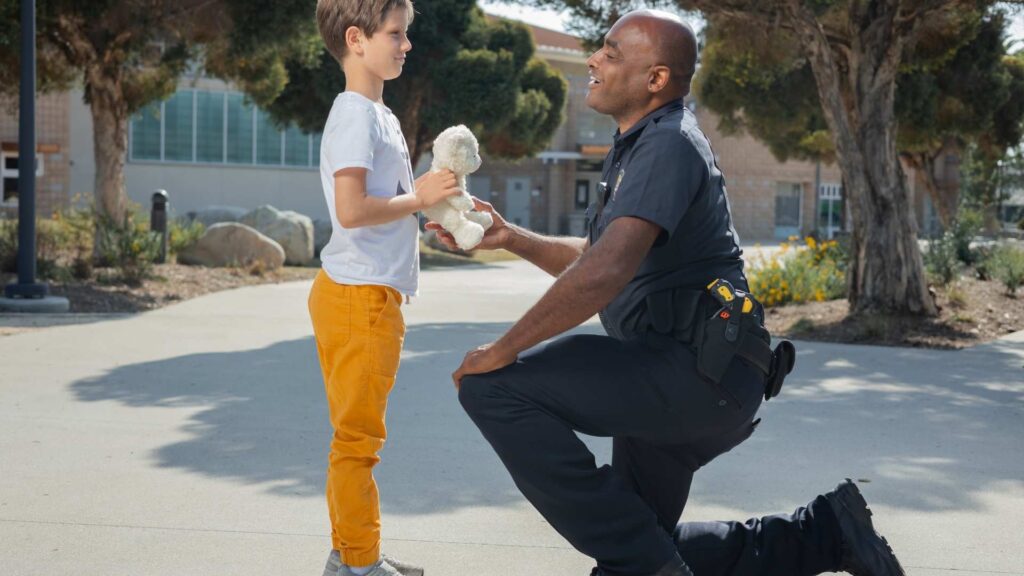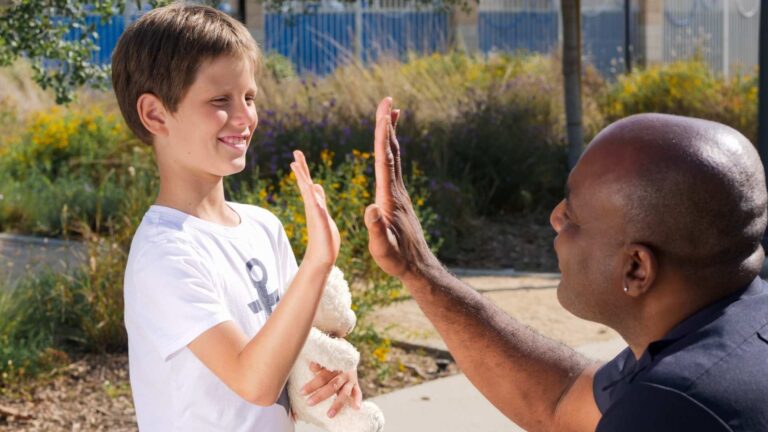Table of Contents
Why are individuals with autism more likely to have encounters with law enforcement?
The relationship between autism and law enforcement can be complex and challenging to navigate. Autism affects how a person communicates, understands information, and interacts with their surroundings. This unique way of managing sensory sensitivities means that behaviors that might be seen as suspicious or criminal by police could actually be responses to the challenges autism presents, such as feeling overwhelmed by sounds or lights, being confused, or trying to calm themselves down.
While the legal system must hold individuals accountable, it must also recognize when someone’s behavior comes from a neurodevelopmental condition. Unfortunately, many neurodiverse individuals end up caught in a system that doesn’t fully understand them. In situations like these, we must pause and ask: how can we do better?
Imagine this: a young man with autism is walking down the street, flapping his hands to calm himself. He avoids eye contact, doesn’t respond to verbal commands, and appears agitated. A police officer approaches, interprets the behavior as suspicious, and escalates the situation. What began as a misunderstanding turned into a crisis.
This isn’t a rare occurrence. In fact, as the number of individuals with Autism Spectrum Disorder (ASD) continues to rise, so does the importance of improving the relationship between autism and law enforcement and, more broadly, the ongoing challenges tied to autism and police encounters.
Keep reading this article by ABA Centers of Connecticut as we explore the current challenges, the need for better autism and police training, and how therapies like ABA can empower neurodiverse individuals for safer, more successful encounters.
Building Safer Interactions: Autism and Law Enforcement

The intersection of autism and law enforcement is a sensitive but essential topic. The Journal of Autism and Developmental Disorders states that nearly one in five individuals with autism will have an interaction with law enforcement by the time they reach adulthood. Unfortunately, these interactions are often fraught with confusion, fear, and misinterpretation.
Autistic behaviors, such as avoiding eye contact, echolalia (repeating words), or not responding to commands, can be mistaken for defiance or aggression. These misunderstandings can escalate encounters quickly, especially when officers are unaware that the individual they’re dealing with is neurodivergent.
A powerful report from Criminal Legal News highlights several cases where a lack of autism and police awareness led to tragic outcomes. In many instances, law enforcement lacked the training to recognize the signs of autism, let alone how to respond appropriately.
So, what can we do? The answer lies in preparation, education, and empathy.
Police Protocol for Autism Spectrum Disorder
Police interactions with neurodiverse people require a tailored approach. While some departments have implemented training programs, there is still no universal Police Protocol for Autism that officers can rely on nationwide.
A paper published on PubMed Central emphasized that police officers often overestimate their understanding of autism. In practice, many still associate autism primarily with intellectual disability or childhood behavior. Without a clear, nationally adopted approach to autism and law enforcement, many officers are left unprepared to handle real-world encounters appropriately.
Some key recommendations for improving police interactions with people with autism include:
- Use of explicit, concrete language: Avoid idioms or abstract commands, as recommended by police protocol for autism training guides.
- De-escalation techniques: Backing off, giving space, and using a calm tone.
- Visual identifiers: Some individuals carry autism ID cards or wear medical bracelets.
- Minimizing sensory triggers: Sirens, shouting, and flashing lights can overload the senses.
Trauma-informed policing models, as highlighted in Autism Spectrum News, are being introduced to complement evolving Police Protocol for Autism strategies aimed at reducing harm during crises.
These approaches encourage law enforcement to recognize signs of trauma and adjust their responses to reduce harm. For individuals with autism, whose experiences with the world can already be overwhelming, this could make all the difference in police interactions with neurodiverse people.
Bridging the Gap: Autism Awareness in Policing Today
Despite growing awareness, there’s still a vast chasm between autism and police. A study featured in the Common Ground Research Network found that while 96% of surveyed officers had heard of autism, only 38% felt confident identifying it in real-life scenarios.
Education is key to improving autism and law enforcement outcomes —and a standardized Police Protocol for Autism would be a significant step toward safer, more consistent interactions. Mandatory autism-specific training, partnerships with local autism organizations, and inclusion of autistic voices in program development are all powerful tools.
It’s also about changing mindsets. Law enforcement culture often prizes authority and control, but dealing with neurodiverse individuals requires flexibility, empathy, and compassion. By recognizing that some behaviors are expressions of anxiety or sensory overload—not threats—police officers can change the trajectory of an encounter.
Parents and caregivers also have a core role. Teaching children and teens how to identify themselves to the police, what to expect in an encounter, and role-playing scenarios can build confidence and reduce fear on both sides.
How ABA Therapy Supports Neurodiverse Individuals Encouraging Effective Interactions
Applied Behavior Analysis (ABA) therapy is one of the most effective tools for helping neurodiverse individuals navigate the world, including police interactions with neurodiverse people. By focusing on communication, emotional regulation, and social skills, ABA prepares individuals for situations that might otherwise cause stress or confusion.
For example, a child in ABA therapy might learn how to react and behave when someone asks for their name, how to use a calm-down strategy, or how to express discomfort using words instead of behaviors that people could misinterpret in autism and police interactions.
Early intervention is especially powerful. When children receive support during key developmental years, they build skills that help them succeed—whether at school, at work, or in the community. These skills also protect them in high-stakes situations, like police interactions with neurodiverse people, by helping them respond in ways that align with a clear Police Protocol for Autism framework and safe, respectful autism and police interactions.
At ABA Centers of Connecticut, we empower families through diagnostic evaluations, early intervention, and personalized ABA therapy. Every child deserves the tools to thrive—and that includes being safe and understood during interactions with law enforcement.
A Path Toward Mutual Understanding
Improving the relationship between autism and law enforcement isn’t about choosing sides—it’s about seeing the whole picture. Neurodiverse individuals deserve dignity, and police officers deserve the training and tools to respond safely and compassionately.
We’ve come a long way, but there’s more to do. We must invest in autism education for law enforcement, empower individuals with life skills, and create systems that value understanding over punishment. Strengthening how we address autism and police encounters is part of that mission—ensuring safety and dignity on both sides.
If you’re a parent, educator, or officer, start with awareness. Seek training. Ask questions. And support policies that prioritize autism and police preparedness.
Looking for support? We’re here for you at ABA Centers of Connecticut. We offer diagnostic services, early intervention, and personalized ABA therapy to help your child build a safe and prosperous future—both in treatment and in the real world, including positive police interactions with neurodiverse people. Call us at (844) 395-0448 or contact us online for a free consultation.
Because actual safety means being seen, understood, and supported.










